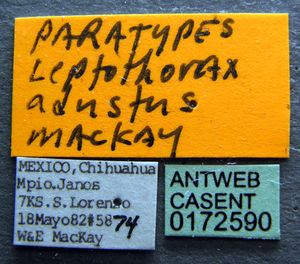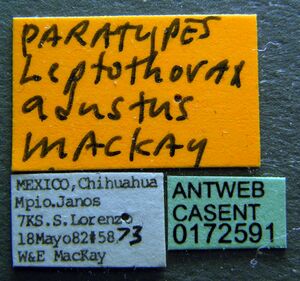Temnothorax adustus
| Temnothorax adustus | |
|---|---|

| |
| Scientific classification | |
| Kingdom: | Animalia |
| Phylum: | Arthropoda |
| Class: | Insecta |
| Order: | Hymenoptera |
| Family: | Formicidae |
| Subfamily: | Myrmicinae |
| Tribe: | Crematogastrini |
| Genus: | Temnothorax |
| Species group: | sallei |
| Species: | T. adustus |
| Binomial name | |
| Temnothorax adustus (Mackay, W.P., 2000) | |
This species is only known from a few collections and appears to be restricted to riparian areas in desert ecosystems. These ants have been found nesting under and in the bark of live cottonwood trees (Populus fremontii), in parts of the tree damaged by other insects.
Identification
Prebus 2017 - A member of the sallei clade.
Mackay (2000) - This is a small, dark species with very tiny propodeal spines, the node of the petiole has a relatively sharp apex and the ventral surface of the peduncle has a small tooth or at least a bump. The antenna has 12 segments. The head is usually partially smooth and shining, although this lack of sculpture may be restricted to only a slender strip.
The sculpturing on the head may result in this species being misidentified as Temnothorax rugithorax. It can be distinguished on the basis of the distribution (Temnothorax rugithorax is from the state of Hidalgo) and that the apex of the petiole is sharp (blunt and rounded in Temnothorax rugithorax).
Keys including this Species
- Key to Temnothorax nitens species group workers
- Key to Temnothorax tricarinatus species group workers
- Key to the New World Temnothorax
Distribution
United States, MEXICO. US: Northern New Mexico; Mexico: Chihuahua.
Latitudinal Distribution Pattern
Latitudinal Range: 36.303° to 29.74888889°.
| North Temperate |
North Subtropical |
Tropical | South Subtropical |
South Temperate |
- Source: AntMaps
Distribution based on Regional Taxon Lists
Nearctic Region: United States.
Neotropical Region: Mexico (type locality).
Distribution based on AntMaps
Distribution based on AntWeb specimens
Check data from AntWeb
Countries Occupied
| Number of countries occupied by this species based on AntWiki Regional Taxon Lists. In general, fewer countries occupied indicates a narrower range, while more countries indicates a more widespread species. |

|
Estimated Abundance
| Relative abundance based on number of AntMaps records per species (this species within the purple bar). Fewer records (to the left) indicates a less abundant/encountered species while more records (to the right) indicates more abundant/encountered species. |

|
Habitat
Temnothorax adustus has been collected in desert riparian areas, associated with cottonwood trees (Populus fremontii).
Abundance
Only known from a few collections.
Biology
Castes
Worker
Images from AntWeb
   
| |
| Paratype of Temnothorax adustus. Worker. Specimen code casent0172590. Photographer April Nobile, uploaded by California Academy of Sciences. | Owned by LACM, Los Angeles, CA, USA. |
Queen
Images from AntWeb
   
| |
| Paratype of Temnothorax adustus. Queen (alate/dealate). Specimen code casent0172589. Photographer April Nobile, uploaded by California Academy of Sciences. | Owned by LACM, Los Angeles, CA, USA. |
Male
Images from AntWeb
    
| |
| Paratype of Temnothorax adustus. Male (alate). Specimen code casent0172591. Photographer April Nobile, uploaded by California Academy of Sciences. | Owned by LACM, Los Angeles, CA, USA. |
Nomenclature
The following information is derived from Barry Bolton's Online Catalogue of the Ants of the World.
- adustus. Leptothorax (Myrafant) adustus Mackay, W.P., 2000: 309, figs. 31, 32, 35, 80, 81 (w.q.m.) MEXICO. Combination in Temnothorax: Bolton, 2003: 271.
Unless otherwise noted the text for the remainder of this section is reported from the publication that includes the original description. Unless otherwise noted the text for the remainder of this section is reported from the publication that includes the original description.
Description
Worker
Mandibles with 5 or 6 teeth, apical and preapical well defined, remainder poorly developed; anterior border of clypeus varies, concave to weakly convex; clypeus with a number of well developed carinae, including medial carina; sides of head weakly convex; vertex broadly. Mesosoma and petiole of the holotype concave; eyes small, but extending worker of Leptothorax adustus. past lateral border of head; scape not reaching occipital corners; maxillary and labial palps short, not extending past buccal cavity; mesosoma nearly straight dorsally, sutures scarcely impressed; propodeum with dorsal face and posterior face nearly equal in length, propodeal angles small and poorly formed; petiole with relatively sharp apex, anterior petiolar face broadly concave, posterior face convex, bottom of peduncle with. small tooth or at least bump; postpetiole not noticeably broadened.
Erect hairs thickened and scattered on all surfaces except legs and scapes; decumbent pubescence scattered on all surfaces, especially obvious on legs and scapes.
Sculpture for the most part fine, consisting of fine striae on sides of head and fine punctures on mesosoma. petiole and postpetiole. central part of head, much of dorsum of mesosoma (especially pronotum) and dorsum of gaster smooth and polished. Top of pronotum mostly punctate, but one specimen is relatively smooth and glossy and also smooth between propodeal spines.
Color concolorous dark brown.
Measurements: HL 0.64-0.70. HW 0.54-0.65. SL 0.49-0.53, EL 0.17-0.18, PW 0.16-0.19, PL 0.19-0.20, PPW 0 .22-0.23, PPL 0.17-0.18. Indices: CI 84-93, SI 76-77, PI 84-95, PPI 74-82.
Queen
Similar to worker in most aspects, except for presence of ocelli. larger eyes and mesosoma modified for flight; striae on head cover nearly all the dorsum, background between striae smooth and shining; dorsum of mesosoma with longitudinal striae, sides of pronotum striate, sides of propodeum rugose, mesopleuron smooth and polished; propodeal angles somewhat more developed than in worker, but still consisting of only angles; petiole with sharp apex, anterior surface only very weakly concave, posterior face nearly 0.5 mm straight, bump on venter of peduncle only weakly developed.
Erect hairs and decumbent pubescence, and color as in worker.
Measurements: HL 0.76-0.79, HW 0.74-0.75, SL 0.58-0.59, EL 0.22-0.23,WL 1.26-1.28. PW 0.23-0.26, PL 0.22-0.25, PPW 0.31-0.32, PPL 0.18-0.19. Indices: CI 94-99. SI 73-78, PI 104-105, PPI 168- 172.
Male
Mandible with well defined apical and subapical teeth; median anterior border of clypeus convex, clypeus with transverse fine rugae; eyes large; ocelli well developed; scape short; palps short; propodeal angles nearly absent; petiole with straight anterior petiolar face. slightly convex posterior face, petiolar node rounded. not angulate as In worker and female.
Erect hairs sparse and covering nearly all surfaces, including legs; decumbent pubescence very sparse.
Sculpture consisting of dense punctures on head, rugae anterior to eyes, transverse rugae on anterior 1/3 to 1/2 of clypeus, dorsum of mesosoma mostly shining, as are sides of mesosoma, side of petiole lightly punctate.
Concolorous dark brown.
Measurements: HL 0.47-0.53, HW 0.46-0.55, SL 0.12-0.14, EL 0.20-0.22, WL 0.91-1.00, PW 0.13-0.16, PL 0.19-0.20, PPW 0.18-0.19, PPL 0.16-0.17. Indices: CI H7- 1l7, SI 23-30, PI 68-80, PPI 106-119.
Type Material
Holotype worker (Museum of Comparative Zoology #5873) 14 paratype workers, 4 paratype females and 15 paratype males (California Academy of Sciences, CIDA, William and Emma Mackay Collection, Los Angeles County Museum of Natural History, MCZC, National Museum of Natural History, Universidad Nacional Autonoma de Mexico). Mexico, Chihuahua: Municipio. Janos, 7KS San Lorenzo, 18 May 1982, W&E. Mackay.
Etymology
Descriptive. "From Latin, adustus for brown, as all castes of this species are concolorous brown"
References
- Bolton, B. 2003. Synopsis and Classification of Formicidae. Mem. Am. Entomol. Inst. 71: 370pp (page 271, Combination in Temnothorax)
- MacKay, W. P. 2000. A review of the New World ants of the subgenus Myrafant, (genus Leptothorax) (Hymenoptera: Formicidae). Sociobiology 36: 265-444 (page 309, figs. 31, 32, 35, 80, 81 worker, queen, male described)
- Mackay, W. P. and E. Mackay. 2002. The ants of New Mexico (Hymenoptera: Formicidae). Edwin Mellen Press, Lewiston, NY.
- Prebus, M. 2017. Insights into the evolution, biogeography and natural history of the acorn ants, genus Temnothorax Mayr (hymenoptera: Formicidae). Bmc Evolutionary Biology. 17:250. doi:10.1186/s12862-017-1095-8 (The doi link to the publication's journal webpage provides access to the 24 files that accompany this article).
- Prebus, M.M. 2021. Taxonomic revision of the Temnothorax salvini clade (Hymenoptera: Formicidae), with a key to the clades of New World Temnothorax. PeerJ 9, e11514 (doi:10.7717/peerj.11514).
References based on Global Ant Biodiversity Informatics
- Dattilo W. et al. 2019. MEXICO ANTS: incidence and abundance along the Nearctic-Neotropical interface. Ecology https://doi.org/10.1002/ecy.2944
- Mackay W. P. 2000. A review of the New World ants of the subgenus Myrafant, (genus Leptothorax) (Hymenoptera: Formicidae). Sociobiology 36: 265-444.
- Mackay W. P. and Mackay, E. E. 2002. The ants of New Mexico (Hymenoptera: Formicidae). Lewiston, New York: Edwin Mellen Press, 400 pp.


